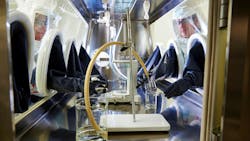MilliporeSigma invests in manufacturing, partnership to target growth of ADCs
The biopharma industry continues to evolve at a rapid pace, and success for contract development and manufacturing organizations (CDMOs) depends on their ability to anticipate and adapt to change.
This is increasingly true as new therapeutic modalities emerge and reshape the pharmaceutical landscape, according to Daniel Teasley, senior director, Global Business Lead, CDMO, for MilliporeSigma, the U.S. and Canada Life Science business of Merck KGaA, Darmstadt, Germany.
The expansion of novel modalities has introduced new opportunities, as well as challenges, across the manufacturing value chain.
“Change has always been a constant in the biotech and pharmaceutical spaces, but I especially see that as true right now,” Teasley says. “And for CDMOs, that’s something we have to respond to.”
Backing up Teasley’s perspective, CRB’s Horizons: Life Sciences Report 2025, which surveyed 400 global R&D and manufacturing professionals, recently found that “across the board, respondents report plans to expand or increase activity in every modality surveyed.” The report also revealed that fewer than 3% of respondents planned to halt work on any modality, signaling broad confidence in continued growth.
Teasley notes that this dynamic approach has also led to companies shifting investment across modalities, driven by changes in economics, policy, and science. According to CRB’s report, 43% of surveyed companies are actively accelerating investment despite uncertainty stemming from U.S. federal policy and agency staffing changes.
Key modalities drive industry forward
CRB’s Horizons report highlighted five major modalities that are shaping the current life sciences landscape: antibody-drug conjugates (ADCs), cell therapies, gene therapies, therapeutic proteins, and small molecules.
Successfully supporting growth in any of this range of modalities requires knowing how to scale and tailor manufacturing to meet each modality’s distinct requirements.
“Each class of modality, and especially novel modalities, have specific needs and capacity or capability and one does not necessarily translate to another,” says Teasley. “And so with different modalities going through ups and downs, as a CDMO, we have to be able to respond and serve our clients’ changing needs in the industry as those modalities fluctuate in the market.”
The Horizons report found that the industry expects net growth across all modalities, with new capacity being built to advance each area of focus. However, double-digit growth is projected for the contract market for ADCs.
A Roots Analysis study estimates the global ADC contract manufacturing market is worth $1.79 billion currently, but is expected to grow to nearly $7 billion by 2035 at a compound annual growth rate of more than 12%.
ADC therapeutics take the spotlight
Among the modalities attracting the most momentum are ADCs, an area of significant strategic focus for MilliporeSigma. Teasley describes ADCs as a modality with rapidly expanding potential and a shift toward earlier use in treatment.
“We see broader implications coming down the pike for ADCs with the potential for earlier use, rather than third-line treatment, and new commercialization’s. All this contributes to a growth that’s important,” says Teasley. “Strong assets are coming through for large pharma and small biotech. If we want to serve that segment effectively, then we need to be in a position where we can increase capacity to meet that need and increase the technology investment to be leaders in that modality.”
ADCs are designed to specifically target cancer cells and deliver cancer-killing drugs directly inside a cell while limiting damage to healthy cells. These therapeutics are “yielding unprecedented precision, and high potency that’s enabled by that precision,” Teasley noted.
Reflecting MilliporeSigma’s commitment to this modality, Teasley points to recent company moves to bolster its capabilities in this market, including a $76 million expansion last year at its Bioconjugation Center of Excellence in St. Louis designed to triple the facility’s manufacturing capacity.
In June 2025, MilliporeSigma formed an alliance with Simtra BioPharma Solutions in the ADC space to provide a turnkey offering, including bioconjugation, drug product formulation development, linker-payload manufacturing, and fill-finish capabilities.
“Our announcements around ADC manufacturing, including the partnership with Simtra BioPharma and investments in St. Louis, are a signal of our commitment to prioritize our investments and effort in that modality to make sure we’re best positioned to serve this as a high-growth market,” Teasley says.
CRB’s Horizons report highlights how ADCs are unique with respect to how they are bolstered by two other major modalities, as they are built by “linking therapeutic proteins (as scaffolding) with small molecules (as the cytotoxic payload),” according to the 2025 Life Sciences Report.
“This synergy explains the closely aligned growth trajectories we’re seeing across all three modalities in our survey data,” according to the report. “As companies double down on ADCs, they’re also scaling investment in the modalities that make them possible.”
Toward this end, MilliporeSigma last week announced plans to acquire the chromatography business of JSR Life Sciences to expand its Protein A capabilities, which will play a critical role in the purification of therapeutic proteins as well as monoclonal antibodies.
“The chromatography business of JSR Life Sciences, once closed, will become part of our Process Solutions business unit enhancing our downstream bioprocessing portfolio and enabling customers to produce biopharmaceuticals more efficiently and reliably,” says Teasley.
Building for broader modalities
While MilliporeSigma is heavily focused on bioconjugation and high-potent synthesis to support ADCs and other conjugate drugs, Teasley contends the company is also advancing capabilities across other high-growth areas, including viral vectors for cell and gene therapies and lipids and lipid nanoparticles (LNPs) to support delivery at a foundational level.
Still, Teasley acknowledges both the significant progress made and the challenges that persist in the broader cell and gene therapy space.
“It is an area where we have and will continue to invest, but the trick is to see how — as a novel modality — it passes through those waves and troughs,” says Teasley. “And I expect that as we emerge from a post-COVID decline in funding in the cell and gene therapy industry, that we’ll continue to see further and further progress as we have in prior years.”
Despite the commercial-scale success achieved over the past decade, ongoing concerns — including recent clinical setbacks and cancellations such as those tied to Sarepta Therapeutics’ gene therapy Elevidys — have contributed to headwinds in this space. These sentiments were highlighted at the annual Cell & Gene Meeting on the Mesa, held earlier this month in Phoenix.
About the Author
Andy Lundin
Senior Editor
Andy Lundin has more than 10 years of experience in business-to-business publishing producing digital content for audiences in the medical and automotive industries, among others. He currently works as Senior Editor for Pharma Manufacturing and is responsible for feature writing and production of the podcast.
His prior publications include MEDQOR, a real-time healthcare business intelligence platform, and Bobit Business Media. Andy graduated from California State University-Fullerton in 2014 with a B.A. in journalism. He lives in Long Beach, California.

